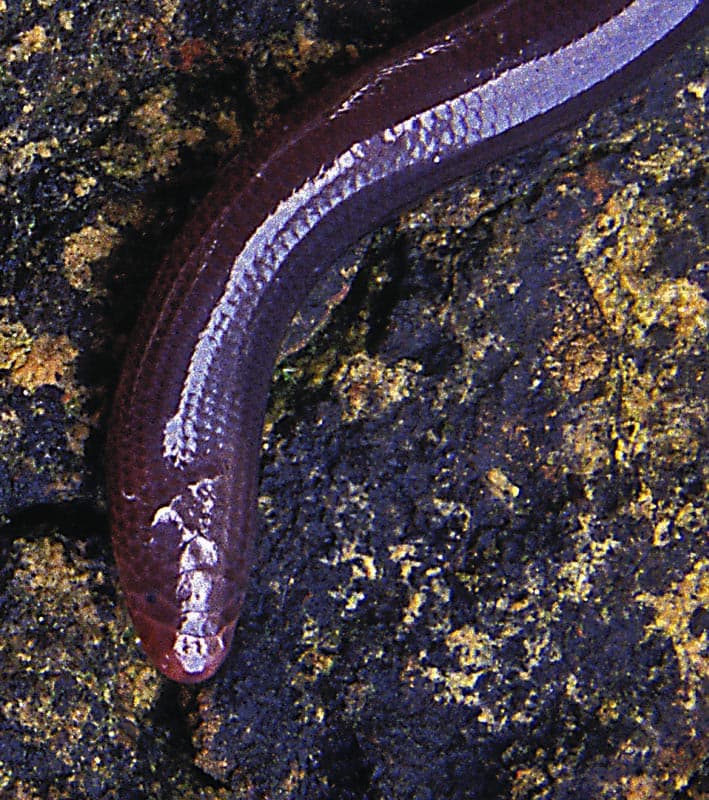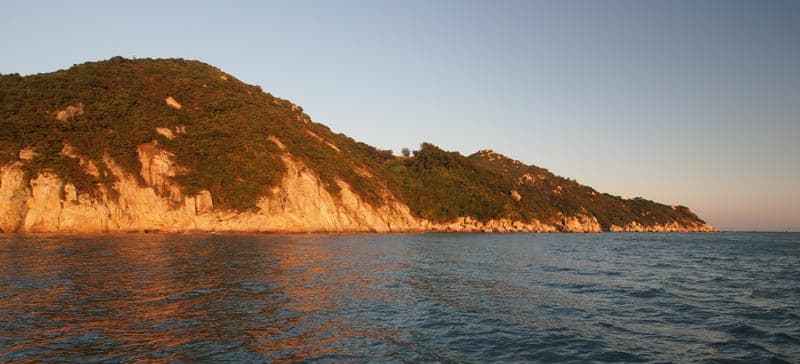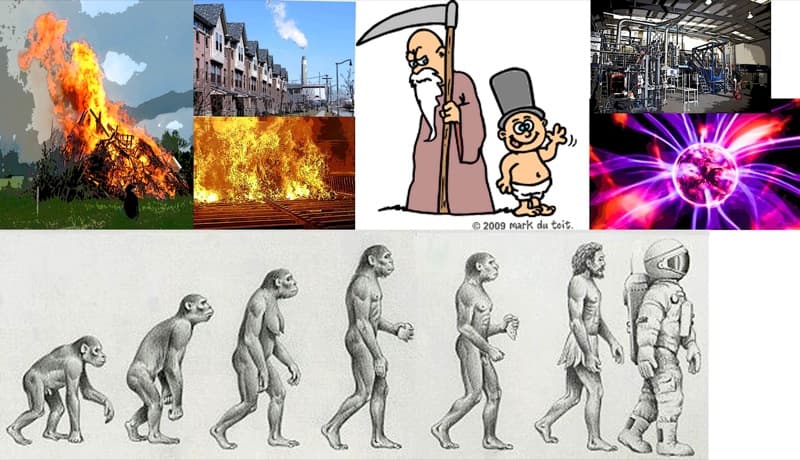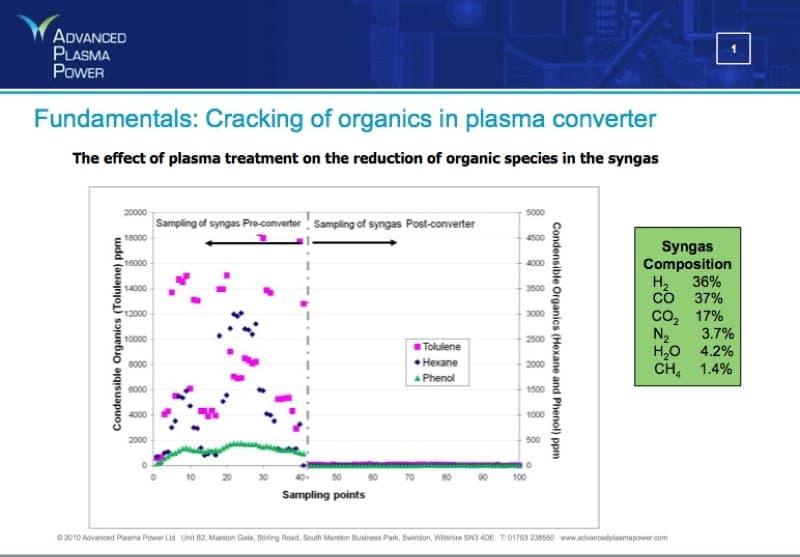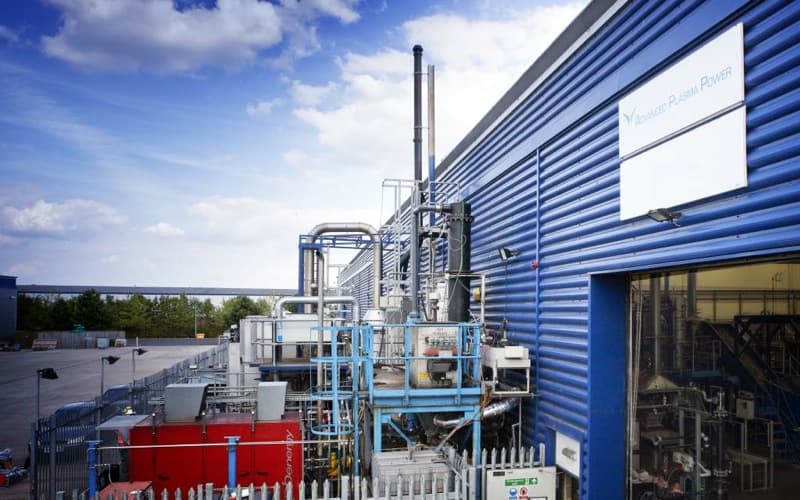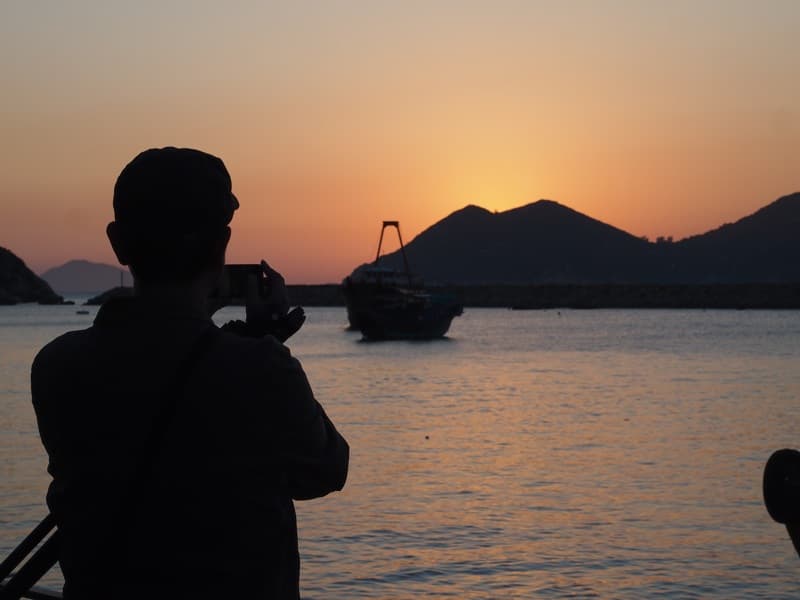- This topic has 0 replies, 1 voice, and was last updated 12 years, 6 months ago by
DocMartin Williams.
- AuthorPosts
- 15 January 2012 at 3:34 am #7274
If you’re on Cheung Chau, look west across the harbour, and you’ll see a small island: Shek Kwu Chau. It appears deserted, but hosts a drug rehabilitation centre.

Wildlife surveys led by US biologist Dr James Lazell, director of the Conservation Agency, have discovered reptiles including two snakes – Hollinrake's Racerand a sub-species of Jade Vine Snake – that are unique to the island, along with Bogadek’s legless lizard, which is known from only three Hong Kong islands. This is one of perhaps eight nesting sites for white-bellied sea-eagle in Hong Kong. Waters along the west coast are key haunts of Hong Kong’s small population of Indo-Pacific finless porpoise, which the International Union for the Conservation of Nature classes as Vulnerable to global extinction.
With the Soko Islands further west, and the beautiful south coast of Lantau to the north, it’s not surprising that in 2001 a government development strategy for the southwest New Territories included a plan to “protect and conserve the relatively unspoilt marine environment while providing recreational and educational opportunities to the public in these areas”.

Yet there was a surprise last year, when the government determined that Shek Kwu Chau was the preferred location for building one of the world’s largest waste incinerators, burning 3000 tonnes of waste per day. Plans call for this to be on an artificial island, constructed just off the southwest coast of Shek Kwu Cha, in prime porpoise habitat. It will be an industrial site with a 150-metre chimney – almost as tall as the HSBC Bank Building.
The incinerator plans have met widespread opposition for a host of reasons, including the damage to wildlife and fisheries, severe impact on scenery in a beautiful area, and massive financial cost. Seventeen groups including Friends of the Earth, Greenpeace Hong Kong, Green Sense and the Living Islands Movement have signed a joint statement outlining their concerns. Plus, incinerator technology is dated, likely threatening public health – and there are cheaper, cleaner, more sophisticated ways to deal with Hong Kong’s waste than simply setting fire to it.
[This is the original draft of an article I wrote for Ming Pao newspaper in Hong Kong; it was translated by Basil Hui, and appeared on 14 January 2012. Scroll down for Chinese version.]
Incineration Dates from the Stone Age

Incineration – using fire as a means of waste disposal – dates back to the Stone Age; humans tamed fire at least a million years ago. The first waste incinerators were built in the late 19th century.
From the late 1960s, Hong Kong turned to incineration to reduce the volume of waste sent to landfills. Four waste incineration plants were built, but in 1989 a government white paper on pollution noted, “Incinerators are a major source of pollution in the urban areas. They account for approximately 18% of all respirable particulates emitted into the atmosphere of the territory and can be a source also of trace quantities of highly toxic substances.” The incinerators were phased out, with the last of them – at Kwai Chung – ceasing operation in 1997.
Incinerator technologies have since improved, such as through greatly reducing emissions of dioxins which, according to the World Health Organization, “are highly toxic and can cause reproductive and developmental problems, damage the immune system, interfere with hormones and also cause cancer”. In 2005, the Hong Kong government published a strategy for dealing with waste, with plans including use of “state-of-the-art technology to treat unavoidable waste in a cost-effective, yet environmentally sustainable, manner”. Conveniently forgetting the 1989 white paper, this announced the core technology would be incineration.
According to the strategy, Hong Kong would first introduce charging for waste disposal; and before waste was sent to the incinerator it would be sorted, so would not include food waste or recyclable materials. Plus, there would be “stringent emission standards that command public confidence”.
It seems the government has since proven even more forgetful. Waste charging remains just an idea, we have little waste separation, and the incinerator will burn predominantly unsorted waste. Though the government makes much of the incinerator using a moving grate for better burning, plus temperatures of around 850C to safeguard against dioxins, there is strong public concern instead of confidence concerning the likely emissions.
Potential Health Hazard
Even the incinerator’s planned design seems cause for concern – as its 150 metre chimney will be the same height as the chimney of the dirty and demolished Kwai Chung Incinerator Plant. Burning unsorted waste will increase the risks of emissions including toxins such as heavy metals and dioxins. Though the Environmental Protection Department claims there will be low levels of toxins, it also highlights the fact that Shek Kwu Chau is in southwest Hong Kong, so prevailing northeasterly winds will often blow away from the territory.
As so often with air pollution, it can be hard to be certain about health impacts of waste incinerators. The British Society for Ecological Medicine has produced one of the best reports on the issue, outlining a host of potential and likely problems, and noting, “probably the most dangerous pollutant of all is the PM2.5 particulate … it is not possible to build a major source of PM2.5 particulates, such as an incinerator, without lives being lost… The majority of studies around incinerators have shown excesses of cancers.”
In the UK, a major study will soon begin assessing evidence suggesting there are significantly higher rates of infant mortalities in areas downwind of incinerators. Other apparent health effects include high rates of asthma around the world’s largest waste incinerator, in Detroit, US.
“In 2006 we assumed that any incineration technology adopted in Hong Kong would be state-of-the-art and ensure that pollutant emissions were minimized to the greatest possible extent,” comments one of Hong Kong’s staunchest campaigners for cleaner air, Professor Anthony Hedley, former Chair Professor of Community Medicine at the University of Hong Kong. “This now appears not to be the case and is unacceptable from a public health viewpoint. This is especially so, given that the EPD is apparently defaulting to depending on air movement to mitigate the impact of emissions locally and will only monitor mass concentrations four times a year.”
It is not only the emissions that are cause for concern. Pollutants that don’t escape as gases will be trapped in the chimney, forming fly ash so toxic that in many jurisdictions it is treated as hazardous waste. According to the British Society for Ecological Medicine, fly ash contains over 98% of dioxins produced by an incinerator together with heavy metals, “making it some of the most toxic material on the planet”.
Plans call for the fly ash plus ash from below the flames to be dumped in the West New Territories Landfill, north of Tuen Mun. Yet there are suspicions that the government’s recently announced plan for a possible artificial island south of Cheung Chau is at least partly to create a more suitable site for dumping the ash. No matter where the ash is headed for, it will be hard to prevent it being blown by the wind, and surely impossible to prevent the toxins escaping into coastal waters over time.
Alternative Technologies: Tried and Tested, and World-changing
Even in 2005, moving grate incineration was far from “state-of-the-art technology”; it was based on techniques first developed in the 1920s. Today, it seems even more primitive – and there are cleaner, cheaper, more sophisticated ways of treating waste.
One way that’s tried and tested is called anaerobic digestion. This involves using micro-organisms to break down organic matter such as food waste – creating methane that can be burnt to produce energy, along with compost. But partly as Hong Kong has little need for compost, its development is rudimentary here.

Another way is truly “state-of-the-art”, and is based on using extremely hot plasma to blast molecules apart [see above], resulting in relatively simple gas mixtures and glassy solids. In 2009, Scientific American described plasma gasification as “lighting in a bottle”, and featured it among “20 Ways to Build a Cleaner, Healthier, Smarter World”.
The Environmental Protection Department seems determined that plasma gasification will not build a cleaner Hong Kong. Deputy director Elvis Au says they have contacted a few technology suppliers, which indicated they cannot meet Hong Kong’s needs.
This assertion conflicts with information from two suppliers. Brian Miloski, Chief Financial Officer of US company Solena, has submitted a proposal to build plasma arc facilities that would treat all Hong Kong waste, using heat to generate electricity, and combining components of the resulting gas to create jet fuel – which could be bought by Cathay Pacific. Though creation of jet fuel from domestic waste seems futuristic, Solena is already working on plans for similar plans together with British Airways, Qantas, SAS, and a consortium of American Airlines. Asked if the process can treat 3000 tonnes of waste per day, Miloski replied, “There is no theoretical limit. The gasification chambers are simple modular and you add on as many as you need.” He advises building the facilities at the three landfills.

UK based Advanced Plasma Power adopts a similarly modular approach to waste treatment. After successful trials with a demonstration plant, they are developing projects including a joint venture to mine over 16 million tonnes of waste from a Belgian landfill, extracting recyclable material such as metal and using gasification to create energy. According to an email to me from Les Liddiard, vice president of sister company Tetronics, Advanced Plasma Power can treat Hong Kong waste, using a combination of modular approach and regional facilities. Just as with Solena, there’s no need to build the gasification plants beside a remote island
The EPD’s consultant for the incinerator project, Aecom, considers that, “scaling up the plasma gasification technology for adoption in the present IWMF [Integrated Waste Management Facility] project would be very risky and hence not advisable.” And yet … in the US, Aecom is involved in a project to gasify about 1200 tons of waste per day, and announced, “We believe that this technology is not only environmentally friendly but ready for large-scale commercialization.”
Contradictions, Questions and Politics
Why such contradictory statements by Aecom in Hong Kong and the US? Well, you might want to consider this: in 2009, Aecom advised that Hong Kong should use incineration; Aecom then conducted the environmental impact assessment to select the site for the incinerator; and in November last year – a month before the environmental impact assessment process was complete – Aecom proudly announced it had been awarded a consultancy contract for developing the incinerator.
There are more contradictions, more questions, regarding the mega incinerator plans. For instance, why has the government dismissed an alternative incineration proposal by Green Island Cement, even though it has conducted a successful pilot project? What are the real reasons Shek Kwu Chau is considered a suitable site for a mega incinerator, especially as the alternative – at Tsang Tsui, near Tuen Mun, is lagoons with power plant ash, of minimal environmental value? Why has no official construction cost been given, and are unofficial estimates of HK$13 billion accurate?
The government claims the incinerator will be attractive, and clean. I once asked Elvis Au: “So why not build it beside Tamar, so government officials can enjoy looking at it?” He replied that the emissions would make the area’s air quality worse than permitted by the Air Quality Objectives. Aha, so this means the incinerator is ok for Shek Kwu Chau, but too dirty for the city.
Now, the key question to ask is surely: Is this time to reconsider our direction, assess possibilities, and find better options, so Hong Kong shows the way forward for waste treatment, not the way backward?
World Cities and Waste
Singapore
Touted as a role model for Hong Kong, with four waste incinerators, and ash sent to a landfill “island” that will be full by 2040.
Toronto, Canada
Strong emphasis on separation of waste, with suitable materials processed by anaerobic digestion. Producing biogas, and aims to use this to power waste trucks.
Manchester, UK
Aiming to become a “world-class city” in terms of waste treatment, building five centres for separation and biological treatment of waste.
Tees Valley, UK
About to build a plasma gasification facility to treat 950 tonnes of waste per day.
San Francisco, US
Adopting a “zero waste” strategy, in which nothing would go to landfills or be incinerated. Currently recovers 77 percent of the materials it discards, with goal of zero waste by 2020.
Hong Kong, Asia’s World City
Plans to build mega-incinerator in beautiful area earmarked for conservation and leisure tourism. Nine recycling centres – around one per 800,000 people, with waste separation and recycling partly reliant on non-governmental organisations, and elderly ladies digging cans from waste bins and collecting newspapers at subway stations.
Dr Martin Williams
I have a PhD in Physical Chemistry from Cambridge University, UK; obtained this through conducting experiments in which used a strong electrical discharge to blast apart water molecules, and followed reactions with a laser. Lived in Hong Kong since 1987, working mainly as freelance writer and photographer specialising in wildlife and conservation issues, as well as environmental consultant, including for World Bank and the Asian Development Bank.
在長洲向西望向對岸石鼓洲,有個戒毒中心,好像有點冷清,可據美國保育局主任、生物學家詹姆斯博士(Dr. Lazell)的調查發現,島上有世上珍稀的蜥蜴和蛇,當中兩個品種——Hollinrake's Racer 和Jade Vine Snake,更是石鼓洲獨有,而鮑氏雙足蜥(Bogadek's legless lizard)亦只在香港三處島嶼有發現。島上並有白腹 海鵰的巢穴,而石鼓洲海域一帶,是受國際保護瀕臨滅絕的江豚的主要棲息地。
再往西是索罟群島,北面是美麗的嶼南沿岸,無怪乎2001 年政府的新界西南發展策略裏,將這「相對未受污染的海 洋環境」納入保育。可是,去年卻竟傳出,政府要在石鼓洲的西南岸建造人工島,首選在石鼓洲興建世上最大的廢 物焚化爐,每天焚燒3000 噸的垃圾。150 米的煙囪,與匯豐銀行大樓一樣高大!
文 Martin Williams 焚化爐是古老石山
用火焚燒廢物可追溯至石器時代,第一家垃圾焚化爐則是建於19 世紀後期。香港於上世紀60 年代後期採用焚化
,興建了4 個垃圾焚化爐,到了1989 年,政府發表白皮書: 「焚化爐是市區的主要污染來源,其排出的微粒約佔
整體微粒的18%,當中有些是含有劇毒的。」下令關閉,到1997 年,葵涌的焚化爐也停止運作。
其後焚化技術有所改進,例如大大減少二噁英的排放量,(據世界衛生組織界定「二噁英具有很強的毒性,並可能 導致生殖和發育問題,損害免疫系統,干擾激素,及可導致癌症」);到了2005 年,政府推出新的廢物處置策略 ,重新考慮以焚化為核心技術處置廢物。根據新策略,香港會先推行廢物處置收費,在將廢物送往焚化前先行分類 ,以保當中不包括食物渣滓和可回收材料。此外,還會有「嚴格的排放標準,以安公眾的信心」。可是政府比誰都 健忘,如今廢物收費只是構想,我們的廢物分類仍處初階起步,而政府推崇的「超級」焚化爐將要焚化的,是未經
分類的廢物。雖然活動爐排是更好的焚化技術,溫度又會增高至850°C以防止排放二噁英,但公眾未能就排放問題放 心。
有風險, 未解決
首先,超級焚化爐的150 米煙囪,跟排放污穢廢氣的已拆卸葵涌焚化爐煙囪,是同一高度;燃燒未經分類的廢物
,亦會增加排放毒素,如重金屬和二噁英的風險。環保署一方面宣稱新焚化爐排出的有毒物質不會超標,另方面
,亦指出了石鼓洲位處香港西南,而香港經常吹東北風,污染物將隨風送回內陸。一般來說,焚化爐對健康的影響
很難確定,英國生態醫學會曾發表一份高水平的報告,並指出「最危險的污染物可能是PM2.5微粒……要建造一個 PM2.5 微粒的主要排放源頭,如焚化爐,而不造成任何人命損失,是不可能的……大部分研究表明,焚化爐附近居
民都有高於正常的患癌率」。英國另一重要研究顯示,焚化爐順風地區有更高嬰兒夭折率,設有世上最垃圾焚化爐
的美國底特律,居民也有高哮喘病發率。 毒素照吹毒物照流
關注香港空氣污染的先驅人物,香港大學公共衛生學院社會醫學系前講座教授賀達理(Professor Hedley)曾批評 :2006 年我們假設香港會採用最先進、污染物排放量最小的焚化技術,現在情况似乎變了,站在公共衛生立場,不 能接受,尤其當環保署要仗賴風向來減低地區排放的影響,而且每年只做四次大型濃度監測,明顯是失職。
不僅是排放量,沒有變成氣體排出的污染物會積聚煙囪內,形成有毒飛灰,飛灰在一些國家被看作有害廢物,據英 國生態醫學會報告指出,焚化爐產生含有逾98%二噁英,與重金屬同為地球上最毒的物質。按計劃,飛灰和爐底灰
將會轉運至屯門新界西堆填區棄置,亦可能埋在政府最近宣布的長洲以南人工島。不管如何,要防止毒素隨風吹散 很困難,要杜絕毒物流入海中更是無可能。
明明有新技術, 有得揀
即使在2005 年,活動爐排技術這發源自20世紀20 年代的基礎技術,已不是「最先進的技術」,今天,世上存在有 更清潔,更便宜,更精密的方法。
經測試及使用的方法之一是厭氧消化技術,原理是利用微生物分解如食物渣滓中的有機物質,過程中產生的沼氣可 回收為能源或作堆肥之用。另一真正「最先進的技術」是等離子體氣化技術,使用非常熱的等離子體去爆破分子 ,過程產生的是相對簡單的氣體混合物和玻璃狀固體。2009 年《科學美國人》(Scientific American)描述此技術為「一盞明燈」,使世界變得「更清潔,更健康,更聰明」,香港環保署卻不認同。助理署長區偉光稱曾接觸一 些技術供應商,認為技術不合乎香港需要,但這說法跟兩家供應商向我提供的資料有矛盾。
美國公司Solena 首席財務總監BrianMiloski 向政府提交了一份建議書,建議香港建造等離子體氣化技術設施處理 廢物,一方面可用熱力發電,另方面廢物可轉化作飛機燃料的可燃氣體——然後可賣給國泰航空。雖然驟耳聽以家 居廢物製造飛機燃料有點天馬行空,實則Solena 公司已經與英航、快達航空、北歐航空和美國航空公司財團發展了 類似計劃。當被問及能否處理3000 公噸廢物時,Miloski 回答說: 「理論上不存在限制。氣化室是簡單的組件 ,可按需要增加。」他建議在三個堆填區內興建有關設施。
英國的Advanced Plasma Power 亦是採用類似組件處理廢物,在試驗成功後,他們正在發展不同計劃,包括與聯營 公司開採比利時一個填埋1600 萬公噸廢物的堆填區,提取可回收再造的材料如金屬等,然後透過氣化產生能量。根 據其姊妹公司Tetronics 副總裁LesLiddiard 給我的電郵表示,Advanced PlasmaPower 公司可結合組件技術和區域 設施,處理香港的廢物。與Solena 的看法一致,使用氣化廠技術根本無必要建在一個偏遠的島嶼旁邊。
環保署委託研究焚化爐的顧問公司AECOM的意見認為,在現有綜合廢物管理設施納入等離子體氣化技術「非常冒險」
,不建議使用,可在老家美國,AECOM 卻有份參與每天氣化處理約1200 公噸垃圾的項目,且宣布: 「我們相信 ,這項技術不僅環保,並已準備好作大規模商業使用。」
未拍板, AECOM 已得合約
為什麼AECOM 公司在香港和美國有互相矛盾的陳述?或者這裏可得到啟示:2009 年AECOM 建議香港焚化廢物 ,AECOM 並據此進行環境影響評估和為焚化爐選址,在去年11 月,即環諮會通過有關環評報告前一個月,AECOM 自
豪地宣布,它已取得發展石鼓洲焚化爐的顧問合約。
就有關超級焚化爐計劃,還有更多的矛盾,更多的問題,例如,何以政府駁回青洲英坭提交的另類焚化爐建議,即
使它已經成功完成試點項目?在屯門曾咀煤灰湖附近興建,對環境損害較小的可行選擇下,以石鼓洲為最後選址的 真正原因是什麼?何以至今政府一直沒有正式公布建築成本,而流傳中的非官方估計130 億港元是否準確?
政府聲稱焚化爐將是美觀和清潔的,我曾經問過環保署區偉光先生: 「為什麼不建在添馬艦旁邊,讓政府官員們可
以享受這美好的建築?」他回答說這樣的話排放量將令區內的空氣污染超標,呀哈!即是焚化爐在石鼓洲就OK,對
市區來說就太骯髒!
現在,明顯最關鍵的問題是:是否我們要重新考慮我們的方向,評估其他可能性,找出更好的選擇,讓香港用向前 走的方式處理廢物,而不是向後倒退?
About Dr Martin Williams
英國劍橋大學物理化學博士,自1987 年起為自由撰稿人和攝影師,專研野生動物和保育問題,又為包括世界銀行和 亞洲開發銀行擔任環境顧問工作。現居香港
世界城市與垃圾 新加坡 被吹捧為香港的示範單位,有四個廢物焚化爐,爐底灰發送「孤島」(圖)處理, 堆填區預計至2040 年爆滿。
加拿大多倫多 大力強調垃圾分類,合適廢料以厭氧消化技術處理,正研發沼氣技術,計劃用於發動垃圾車。 英國曼徹斯特 目標在廢物處理方面成為「世界級城市」,正興建五個廢物分類及使用生物分解處理廢物的設施。 英國Tees Valley 正建造一個等離子體氣化設施,以處理每天950 公噸的垃圾。 美國三藩市 目標2020 年達至「零廢物」,即送到垃圾堆填區或焚化的廢物目標是零,目前回收再用率已達77%。 中國北京、上海、武漢等城市
- AuthorPosts
- You must be logged in to reply to this topic.


